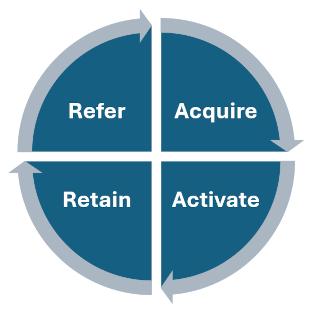Product-Led Growth Flywheel
Overview
In today's competitive business landscape, companies are increasingly adopting innovative strategies to drive growth. One such approach is the Product-Led Growth (PLG) Flywheel, which places the product at the center of user acquisition, retention, and expansion. This model emphasizes creating a product that not only meets user needs but also encourages them to become advocates for the brand.
What is the Product-Led Growth Flywheel?
The Product-Led Growth Flywheel is a framework that visualizes the continuous cycle of user engagement and growth through four key stages: Acquire, Activate, Retain, and Refer. Each stage is designed to enhance user experience and foster a self-sustaining growth cycle:

- Acquire: This initial stage focuses on attracting new users to try the product. Strategies may include content marketing, SEO, social media outreach, and referral programs.
- Activate: Once users are acquired, the goal is to engage them effectively so they experience the product's value quickly. This might involve onboarding processes that guide users through key features.
- Retain: Retention is critical for long-term success. Companies must ensure that users continue to find value in the product, which can be achieved through excellent customer support and regular updates.
- Refer: Satisfied users are encouraged to refer others, creating a cycle where new users are continually brought into the fold through positive word-of-mouth and incentives for referrals.
Why is the PLG Flywheel Gaining Popularity?
The PLG Flywheel has become a favored strategy for several reasons:
- User-Centric Focus: By prioritizing user experience, businesses can create products that resonate with their audience, leading to higher satisfaction and loyalty.
- Cost-Effective Growth: This model often reduces customer acquisition costs by leveraging existing users as advocates, making it more efficient than traditional sales-driven approaches.
- Alignment with Modern Buying Behavior: As consumers increasingly rely on peer recommendations and self-service options, a product-led approach aligns well with how people discover and purchase software today[1][2].
Benefits of Implementing a PLG Flywheel
- Enhanced User Experience: The flywheel encourages continuous improvement of the product based on user feedback, leading to a better overall experience.
- Sustainable Growth: By fostering a cycle of acquisition and retention through user advocacy, businesses can achieve sustainable growth without relying heavily on marketing spend.
- Cross-Functional Collaboration: The flywheel model promotes alignment across various teams—marketing, sales, and customer success—ensuring everyone works towards common goals[3][4].
Challenges of the Product-Led Growth Flywheel
While there are many advantages to adopting a PLG Flywheel approach, there are also challenges:
- Complex Implementation: Transitioning from traditional sales models to a flywheel framework requires significant changes in company culture and processes.
- Resource Intensive: Maintaining momentum in the flywheel demands ongoing investment in user engagement strategies and product improvements.
- Risk of Misalignment: Without clear communication and shared objectives among teams, efforts can become disjointed, slowing down growth[5][6].
Conclusion
The Product-Led Growth Flywheel represents a transformative approach to business growth that centers around delivering exceptional product experiences. By focusing on acquiring, activating, retaining, and referring users through a seamless cycle, companies can create sustainable growth driven by their products. As businesses continue to adapt to changing consumer behaviors and market dynamics, embracing this model could be key to achieving long-term success in an increasingly competitive environment.
